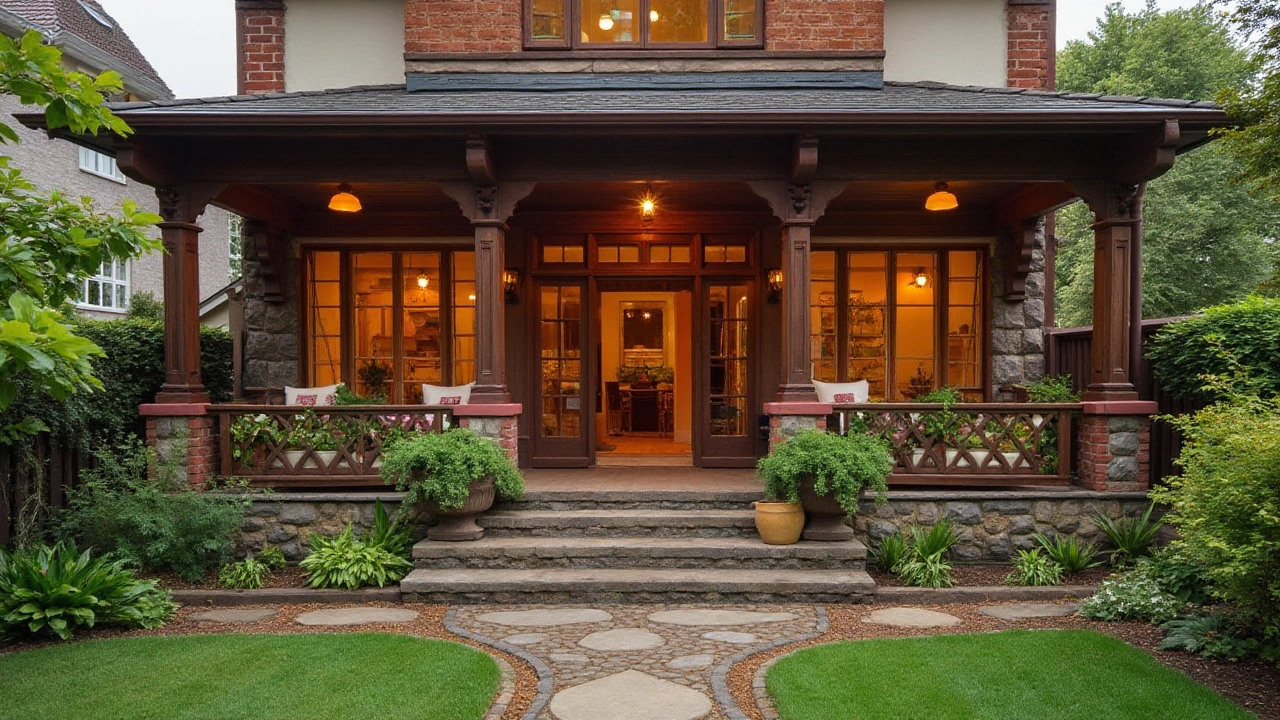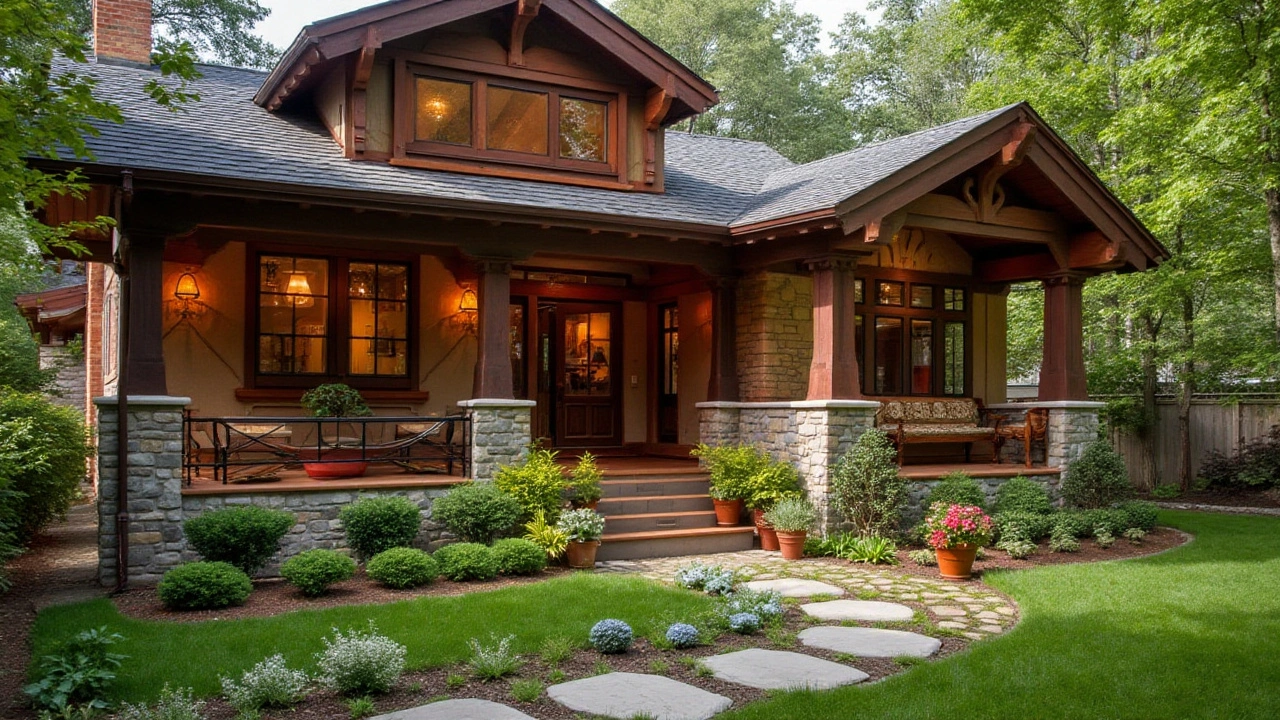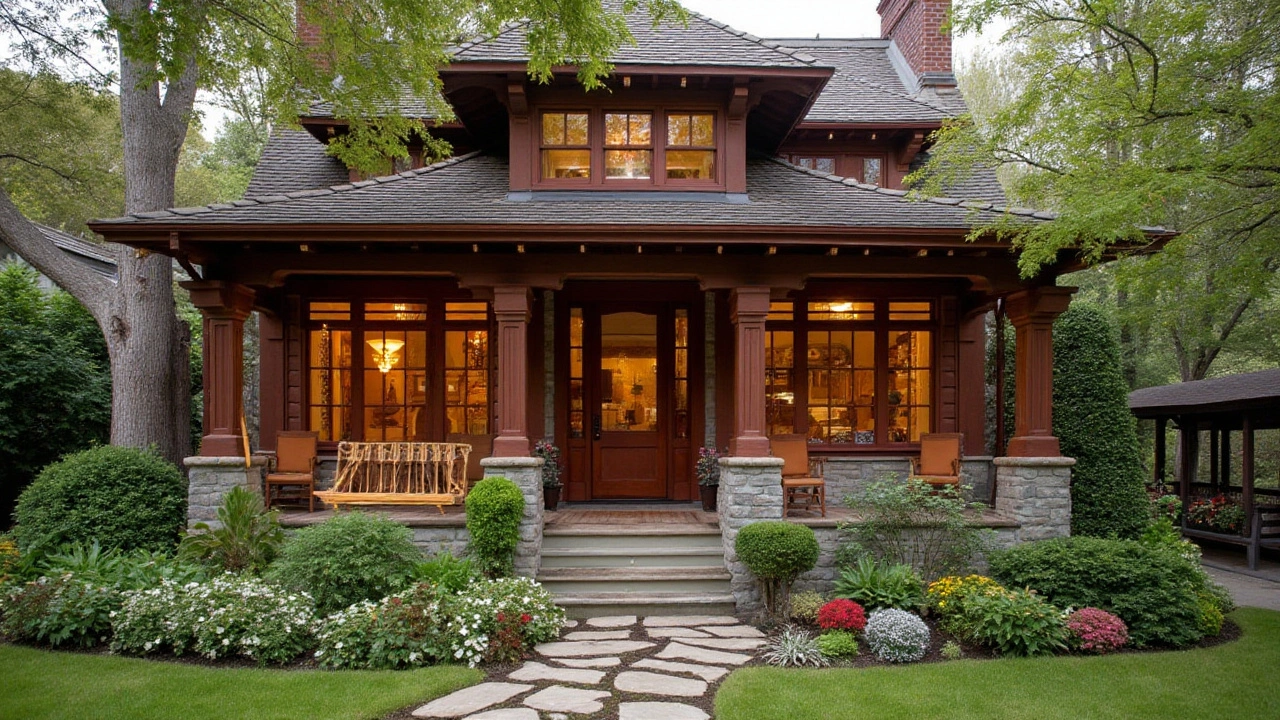The American Craftsman Style: A Renaissance
 Aug, 19 2024
Aug, 19 2024
The American Craftsman style is reclaiming its spot in modern home design, blending nostalgia with contemporary living. Known for its rich history and meticulous craftsmanship, this style invokes a sense of warmth and authenticity that's hard to find in today’s fast-paced world.
Let’s explore the roots of this iconic architectural style, the core features that define it, contemporary variations, and practical tips for incorporating Craftsman elements into your home.
- The Origins of the American Craftsman Style
- Key Features and Elements
- Modern Interpretations
- Tips for Integrating Craftsman Style into Your Home
The Origins of the American Craftsman Style
Dating back to the late 19th and early 20th centuries, the American Craftsman style emerged as a rebellion against the industrial revolution and its mass-produced, overly ornate designs. This architectural movement was part of the broader Arts and Crafts movement, which began in Britain and quickly spread across the Atlantic. At its core, the Craftsman style emphasized simplicity, hand-crafted quality, and the use of natural materials such as wood, stone, and brick.
The origins of the American Craftsman style can be traced to the influential works of architects like Gustav Stickley. Stickley, widely regarded as the father of the American Arts and Crafts movement, published a magazine called 'The Craftsman' which showcased simple, yet functional home designs. In his 1909 book, Stickley wrote, "The quiet, restful lines of the Craftsman house seem to renew the spirit of those who dwell within its walls." His work emphasized the beauty of artisan craftsmanship which stood in stark contrast to industrially produced goods of the time.
The style gained immense popularity through the plans and patterns published in catalogs, which made it accessible to the average American family. This reach was bolstered by companies such as Sears, Roebuck, and Co., which began selling mail-order kits for homes. These kits included all the necessary materials and detailed instructions, allowing families to build their own Craftsman homes.
Several key factors influenced the rise of this beloved architectural style. Firstly, it provided a sense of individuality and personal expression, contrasting sharply with the cookie-cutter homes of the era. Secondly, it championed a return to traditional craftsmanship at a time when many feared the loss of artisan skills due to industrialization. Finally, it created spaces that felt warm, inviting, and deeply human, qualities that were coveted in the bustling pace of the early 20th century America.
The influence of the American Craftsman style extended beyond architecture. It also manifested in the furnishings and interiors of homes. Gustav Stickley's furniture, Roycroft's leather goods and pottery, and Tiffany's stained-glass lamps became symbols of the movement. Characterized by their sturdy construction, simple lines, and use of high-quality, natural materials, these pieces complemented the architectural integrity of Craftsman homes.
While the popularity of the Craftsman style waned with the rise of modernism mid-century, it never truly disappeared. Many of its principles have continued to influence architects and designers. Its reemergence in recent years speaks volumes about the timeless appeal of hand-crafted quality and the human touch in home design.
Today, as people seek to reconnect with more authentic, natural elements in their living spaces, the American Craftsman style is being rediscovered and celebrated. It's not just about aesthetics; it's about a return to intentional living and the appreciation of skilled artistry emblazoned in each handcrafted detail.

Key Features and Elements
When we talk about the American Craftsman style, it's impossible to ignore the hallmark features that make these homes a standout in any neighborhood. These elements blend beauty and functionality, a marriage of form and utility that has fascinated architects and homeowners alike for over a century.
The first thing you notice about Craftsman homes is the low-pitched, gabled roofs. These roofs often extend beyond the home's walls, creating wide eaves that can serve both aesthetic and practical purposes, such as sheltering a porch or providing shade. This characteristic lends a sturdy, grounded appearance, almost like the home is hugging the earth.
Speaking of porches, they are an essential feature in Craftsman architecture. An inviting front porch spans the length of the home, supported by tapered columns on stone or brick piers. Not just decorative, these elements offer outdoor living space that's just as integral as the indoor areas. You can envision lazy Sunday afternoons spent in rocking chairs, engaging with neighbors.
Another key feature is the use of natural materials. Craftsman homes often incorporate local stone, wood, and brick. The emphasis on natural materials extends indoors, where built-in cabinets, bookshelves, and window seats made from rich, dark woods like oak or mahogany add both charm and storage solutions. The interior often features exposed beams and rafters, enhancing the home's rugged appeal.
The open floor plan is another standout aspect of Craftsman homes. Rather than a series of boxed-in rooms, Craftsman design favors flowing spaces that allow for easy movement and interaction. This was revolutionary when the style first gained popularity in the early 20th century, shifting away from the more compartmentalized designs of Victorian houses.
Windows in a Craftsman home are also unique. Double-hung with divided lights in the upper sash, they’re crafted to bring in ample natural light while offering easy ventilation. The use of stained glass or leaded glass in small accent windows can add a touch of elegance, elevating the simplicity of the design.
One can't overlook the influence of the Arts and Crafts movement on Craftsman design. This influence is evident in the intricate, handmade details that are thoughtfully integrated into every aspect. Whether it’s the custom-made fireplace tiles or the handcrafted door hardware, these details radiate a deep appreciation for artisanal work that stands the test of time.
Sarah Susanka, renowned architect and author of 'The Not So Big House' series, once said, "The Craftsman style touches us because it brings us closer to the art of building things by hand - it’s a sensory experience that modern, mass-produced homes lack."
In summary, the Craftsman style isn't just about aesthetics; it’s about creating a home environment that prioritizes quality, functionality, and sustainability. These core features not only define the style but also contribute to its lasting appeal, making the Craftsman a perennial favorite in American home design.

Modern Interpretations
In recent years, the American Craftsman style has seen a resurgence, proving that its timeless appeal is here to stay. While the core principles of the style remain unchanged, contemporary adaptations have emerged, blending traditional elements with modern functionality. One of the first things people notice in these modern interpretations is the emphasis on quality materials and hand-crafted details. However, these homes are now equipped with modern amenities, perfectly suited for today’s lifestyle.
An important aspect of modern Craftsman homes is the open floor plan. Unlike the compartmentalized spaces of the early 20th century, today's designs prioritize a seamless flow between living areas. This not only creates a spacious atmosphere but also enhances natural light, making the home feel more welcoming. Typically, you’ll find large windows and wide doorways connecting the living room to the kitchen and other common areas.
Eco-friendliness is another significant adaptation. Homeowners and builders are more environmentally conscious, opting for sustainable materials and energy-efficient technologies. Bamboo floors, recycled glass countertops, and low-VOC paints are just a few examples of eco-friendly choices that work well within the Craftsman aesthetic. Solar panels and smart home systems are also being seamlessly integrated, allowing the home to be both stylish and green.
Many modern Craftsman homes often feature minimalist furnishings while still embracing traditional elements like built-in cabinetry and handcrafted woodwork. The color palette remains warm and earthy but is complemented by contemporary accents such as stainless steel appliances and sleek lighting fixtures. This mix creates a visually appealing yet cozy atmosphere that appeals to younger generations without alienating traditionalists.
Outdoor spaces in modern Craftsman homes have also evolved. Porches are still a staple, but now they often come equipped with weather-resistant furniture and modern amenities like outdoor kitchens or fire pits. Landscaping tends to focus on native plants and water-efficient gardens, adding to the home’s eco-friendly ethos. These additions offer a perfect blend of indoor and outdoor living, extending the comfort of the home to the yard.
Technology has played a huge role in making Craftsman homes more functional for today’s needs. Smart home technologies like automated lighting, climate control, and security systems are being incorporated without detracting from the traditional aesthetic. These technologies offer convenience and safety, making the home both beautiful and practical.
Despite these modern twists, the essence of the American Craftsman style remains: emphasizing natural materials, hand-crafted quality, and a cozy, welcoming vibe. Its ability to adapt while staying true to its roots is likely why this style is making such a strong comeback.
“The American Craftsman style is a perfect blend of artistry and functionality, making it ideal for contemporary lifestyles while retaining its historical charm,” says interior design expert Jane Thompson.
With its blend of old-world charm and modern amenities, the American Craftsman style offers a unique opportunity for homeowners to enjoy the best of both worlds. Whether you are renovating an old house or building a new one, incorporating Craftsman elements can create a space that feels timeless yet modern.

Tips for Integrating Craftsman Style into Your Home
Creating a home with the timeless appeal of American Craftsman style isn’t as daunting as it may seem. This aesthetic focuses on simplicity, quality, and a connection to nature, making it an ideal choice for those looking to embrace fine craftsmanship and cozy living. Here are some practical tips to help you bring this enduring style into your space.
One key element of Craftsman homes is the use of natural materials. Opt for hardwood floors, stone fireplaces, and wooden beams to capture that authentic feel. Oak, cherry, and maple are popular wood choices that contribute to the warm, inviting atmosphere. Natural stone, like granite or slate, can be used for countertops, fireplace surrounds, and even flooring.
Handcrafted details are another hallmark of this style. Look for furniture pieces with visible joinery, such as dovetail joints, which showcase the quality and care put into construction. Custom cabinetry with inset doors and drawers, often in rich wood tones, can make a significant impact. To elevate your decor, consider incorporating built-ins, such as bookcases or window seats, which add both function and charm.
Color palettes in Craftsman homes are typically inspired by nature. Think earthy tones like greens, browns, and deep reds. These colors not only enhance the natural materials used in the home but also contribute to a serene, grounded environment. To brighten up spaces, add accents of creamy whites or soft yellows, which can provide a refreshing contrast.
Lighting also plays a critical role in achieving the right ambiance. Traditional Craftsman lighting fixtures often feature simple yet elegant designs with stained glass shades or metalwork. Keep an eye out for mission-style lamps, sconces, and chandeliers to maintain authenticity. Using warm, soft lighting will further enhance the cozy atmosphere.
Details like hardware and accessories can also make a big difference. Opt for metal finishes like oil-rubbed bronze or antique brass for door handles, cabinet pulls, and light switch plates. These finishes add a touch of vintage appeal. When it comes to textiles, choose fabrics that have a natural feel, such as linen, wool, and cotton. Look for patterns that reflect the era, like bold geometrics or simple florals.
Integrating Craftsman style doesn’t mean you have to forgo modern conveniences. Many homeowners successfully blend this classic look with contemporary elements. For example, you can incorporate modern appliances in the kitchen but surround them with custom wood cabinetry. In living areas, mix vintage furniture pieces with contemporary sofas or chairs to create a balanced, eclectic look.
"The beauty of the American Craftsman style lies in its attention to detail and respect for materials," says renowned interior designer Sarah Richardson. "It’s about creating a space that feels handcrafted and thoughtfully curated."
If you're handy or enjoy DIY projects, there are plenty of ways to add Craftsman charm on your own. Consider installing wainscoting or beadboard on walls for added texture and visual interest. Adding simple, square-edged trim around doors and windows can also evoke the style’s signature look. And don’t forget about the exterior – a Craftsman home’s curb appeal often features features like tapered columns, a covered front porch, and exposed rafters.
Craftsman homes are all about building a sense of community and connection, so don’t hesitate to integrate elements that reflect your personality and lifestyle. Whether it's displaying handmade pottery, incorporating family heirlooms, or creating an inviting seating area, these personal touches will make your Craftsman-style home truly your own.